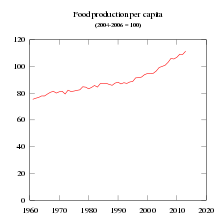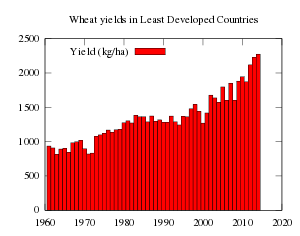Agricultural productivity




Agricultural productivity is measured as the ratio of agricultural outputs to inputs.[1] While individual products are usually measured by weight, which is known as crop yield, varying products make measuring overall agricultural output difficult. Therefore, agricultural productivity is usually measured as the market value of the final output. This productivity can be compared to many different types of inputs such as labour or land. Such comparisons are called partial measures of productivity.[2]
Agricultural productivity may also be measured by what is termed total factor productivity (TFP). This method of calculating agricultural productivity compares an index of agricultural inputs to an index of outputs. This measure of agricultural productivity was established to remedy the shortcomings of the partial measures of productivity; notably that it is often hard to identify the factors cause them to change. Changes in TFP are usually attributed to technological improvements.[3]
Agricultural productivity is an important component of food security.[4] Increasing agricultural productivity through sustainable practices can be an important way to decrease the amount of land needed for farming and slow environmental degradation and climate change through processes like deforestation.[5]
Sources of agricultural productivity

Productivity is driven by changes in either agricultural technique or improvements in technology. Some sources of changes in agricultural productivity have included:[7]
- Mechanization
- High yield varieties, which were the basis of the Green revolution
- Fertilizers: Primary plant nutrients: nitrogen, phosphorus and potassium[8][9] and secondary nutrients such as sulfur, zinc, copper, manganese, calcium, magnesium and molybdenum on deficient soil
- Education in management and entrepreneurial techniques to decrease fixed and variable costs and optimise manpower
- Liming of acid soils to raise pH and to provide calcium and magnesium
- Irrigation
- Herbicides
- Genetic engineering
- Pesticides
- Increased plant density
- Animal feed made more digestible by processing
- Keeping animals indoors in cold weather
See:
Impact
The productivity of a region's farms is important for many reasons. Aside from providing more food, increasing the productivity of farms affects the region's prospects for growth and competitiveness on the agricultural market, income distribution and savings, and labour migration. An increase in a region's agricultural productivity implies a more efficient distribution of scarce resources. As farmers adopt new techniques and differences, the more productive farmers benefit from an increase in their welfare while farmers who are not productive enough will exit the market to seek success elsewhere.[10]
As a region's farms become more productive, its comparative advantage in agricultural products increases, which means that it can produce these products at a lower opportunity cost than can other regions.[11] Therefore, the region becomes more competitive on the world market, which means that it can attract more consumers since they are able to buy more of the products offered for the same amount of money. As productivity improvement leads to falling food prices, this automatically leads to increases in real income elsewhere.[12]
Increases in agricultural productivity lead also to agricultural growth and can help to alleviate

It is not only the people employed in agriculture who benefit from increases in agricultural productivity. Those employed in other sectors also enjoy lower food prices and a more stable food supply. Their wages may also increase.[13]
Food security
Agricultural productivity is becoming increasingly important as the
Higher global food prices between 2006 and 2008, primarily caused by an increasing amount arable land used for growing biofuels and the growing economies in China and elsewhere causing an increase in demand for meat products (which are less efficient than plants in terms of land use), caused the percentage of incomes used for food to increase throughout the world, forcing families to cut back on various other expenditures such as schooling for girls. In areas of sub-Saharan Africa, a decreased agricultural productivity due to crop failures has caused starvation.[15] On the other hand, higher global prices actually mean farmers with successful yields earn more, and this thus increases their productivity.[16]
Investing in the agricultural productivity of women in farming communities is of particular importance in boosting
Relation to population growth
Some critics claim that increasing agricultural productivity results in
However, unlike other animals, in humans greater development and prosperity has led to lower fecundity. Thus as productivity has increased and poverty has been reduced worldwide, population growth is declining. Research suggests we may actually face a declining world population in the future.[19][20]
Inverse relationship theory


Deolalikar in 1981 investigated the theory first proposed by Sen in 1975 that in traditional, pre-modern farming in
Nonetheless, increasing agricultural productivity amongst
Sustainable increases in productivity
Because
Not all
See also
- Agricultural expansion
- Energy efficiency in agriculture
- Food vs. feed
- Green Revolution
- Mechanized agriculture
- Productivity
- Productivity improving technologies (historical)Section 4: Mechanized agriculture, Section 6: Scientific agriculture
References
Citations
- ^ Measuring Agricultural Productivity Using the Average Productivity Index (API) by Lal Mervin Dharmasiri [1] Archived 2013-10-20 at the Wayback Machine
- S2CID 154456202.
- ^ Agricultural Investment and Productivity in Developing Countries, FAO Economic And Social Development Paper No. 148, ed. Lydia Zepeda, 2001, FAO Corporate Document Repository, 12 July 2007, http://www.fao.org/docrep/003/X9447E/x9447e00.HTM.[2]
- ^ Mbow et al. 2019, p. 454.
- ^ a b c "Sustainable Intensification for Smallholders". Project Drawdown. 2020-02-06. Retrieved 2020-10-16.
- ^ Fischer, R. A.; Byerlee, Eric; Edmeades, E. O. "Can Technology Deliver on the Yield Challenge to 2050" (PDF). Expert Meeting on How to Feed the World. Food and Agriculture Organization of the United Nations. Archived from the original (PDF) on 2017-08-09.
- S2CID 84059626.
- ^ About IPNI, the International Plant Nutrition Institute
- ^ The Fertilizer Institute
- ^ Mundlak, Yair, "Agricultural Productivity and Economic Policies: Concepts and Measurements," OECD Working Paper No. 75, OECD Development Center, August 1992, SourceOECD.org, 13 July 2007 http://miranda.sourceoecd.org/vl=4172647/cl=20/nw=1/rpsv/cgi-bin/wppdf?file=5lgsjhvj7g21.pdf[permanent dead link] (13–16).
- ISBN 1-57766-267-9.
- OCLC 237794267.
- ^ a b Promoting Pro-Poor Growth: Agriculture, DAC Guidelines and Reference Series, Paris: OECD, 2006, OECD.org, 13 July 2007 "37922155.pdf" (PDF). Archived from the original (PDF) on 2007-08-17. Retrieved 2007-07-13. (10).
- ^ a b Brown, Lester R. Plan B 2.0: Rescuing a Planet Under Stress and a Civilization in Trouble. New York City: Earth Policy Institute, 2006.
- ^ a b c Kumar, Alok; Al Mahmood Mosfeq, Abdullah, eds. (2012). Hunger, Agricultural Production, and Government Policies (PDF). Department of Economics, University of Victoria. pp. 1–31.
- ^ "The perfect storm: Global food prices hit six-year high". Al Jazeera English. 13 March 2021. Retrieved 14 March 2021.
- ^ Russell Hopfenberg; David Pimentel. "Human population numbers as a function of food supply" (PDF).
- S2CID 54798262.
- ^ Wise, Jeff (9 January 2013). "About That Overpopulation Problem". Slate. The Slate Group. Retrieved 11 March 2021.
- ^ Tupy, Marian L. (10 January 2013). "Prosperity and World Population Growth". Cato Institute. Retrieved 11 March 2021.
- JSTOR 1239565.
- doi:10.1177/205684601072 (inactive 31 January 2024).)
{{cite encyclopedia}}: CS1 maint: DOI inactive as of January 2024 (link - ^ Goals, sustainable development. "Sustainable agriculture".
- ^ Mbow et al. 2019, pp. 439–442.
Cited sources
- Mbow, C.; Rosenzweig, C.; Barioni, L. G.; Benton, T.; et al. (2019). "Chapter 5: Food Security" (PDF). Climate Change and Land: an IPCC special report on climate change, desertification, land degradation, sustainable land management, food security, and greenhouse gas fluxes in terrestrial ecosystems. p. 454.
